Architecture and works contained in the various rooms of the Doge's Palace in Venice
The visit to the Doge's Palace proceeds through rooms that are often - due to the number and importance of the works contained - of the small museums in the Palace: below we show each room with each contained work, the authors and the dating. The first rooms after the entrance constitute the Opera Museum.
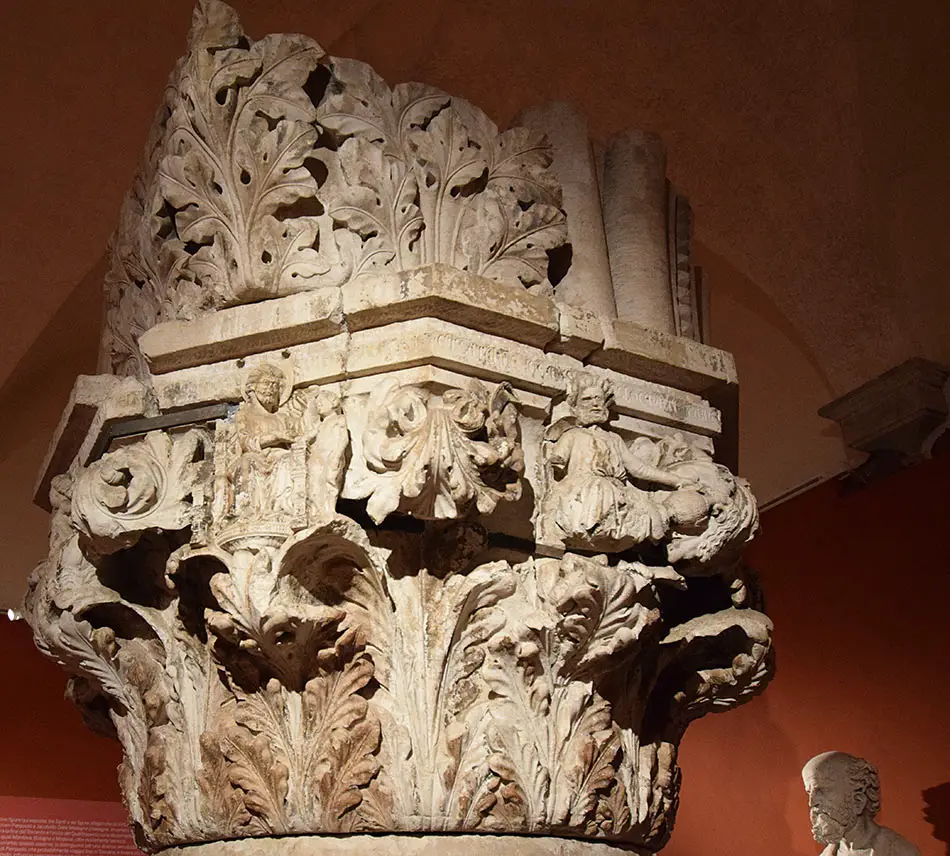
Opera Museum
The Opera was the office in charge of conservation work that the palace needed over the centuries. In 1875 a major restoration work was carried out during which 45 capitals of the colonnade of the portico on the ground floor and the loggia were replaced. Now they are kept in the Museo dell'Opera, along with other sculptural finds from the medieval period; in room 1 you can see a beautiful fourteenth-century capital with Solomon and the seven wise to represent the liberal arts: Priscum grammar, Aristotle the dialectic, Cicero the rhetoric, Pythagoras the artimetics, Euclide the geometry, Tublkain the muscia, Ptolemy the astrology . Solomon represents the wisdom of God: the date of realization is 1344.
Room 2 preserves capitals once upon a time on the portico on the side of the Piazzetta; one of these represents the mechanical arts embodied in the figures of a stonemason, a goldsmith, a peasant, a carpenter, a cobbler, a blacksmith, a notary, a cereal weigher.
Room 3 preserves capitals of the fourteenth century including the capital once in the Piazzetta under the group of Adam and Eve, and the capital of deadly sins: pride, sloth, lust, envy, avarice, anger and throat. There is also vanity, because once was a capital vice then merged into pride. The following rooms still have a series of capitals and ancient columns placed once in the porch, while room 6 hosts 29 capitals of the loggia. The difference in the sculptural system that here becomes decorative and less allegorical and narrative because the image, which for the eyes of a medieval citizen assumed fundamental importance, placed on the first floor was too distant from the people to fulfill the propaganda to his task of civic and religious education.
This room also preserves the original architrave of the Porta della Carta, with the inscription OP.BARTOLOMEI, that is the work of Bartolomeo da Bon between 1439 and 1442, as stated in the Archivio di Stato ai Frari: "... which door was the work of master Bortolo Tajapietra from Santa Maria dell'Orto. " Cost 1700 ducats.
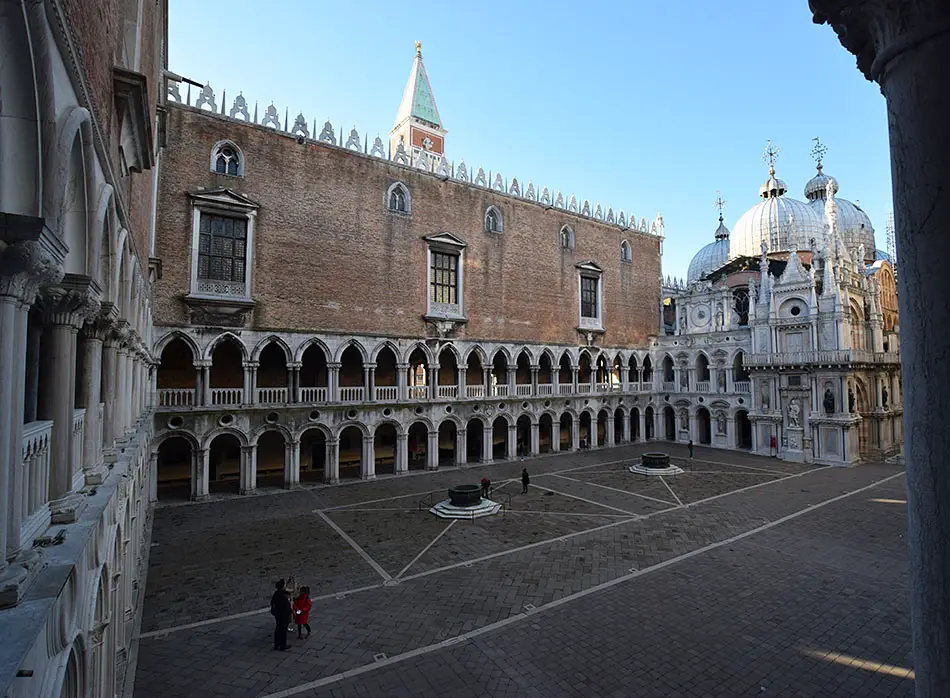
The courtyard
It has a double row of columns, on the ground floor and the loggia, on three sides and on the basilica side a facade with a clock (1615). At the center there are two bronze sixteenth-century wells, by Gian Francesco Alberghetti (1559) and by Nicol� dei Conti (1556). Next to the staircase is the Triumphal Arch of the Doge Francesco Foscari (1423-1457). On the right is the Scala dei Giganti, the entrance of honor to the palace, with the statues of Neptune on the right and Marte, a work by Sansovino (1565), representing power over the sea and in the land of the Serenissima. To the right of the Scala is the Senator Courtyard, where they gathered before meetings. Under the portico you can see the Scala dei Censori (1525) of Scarpagnino.
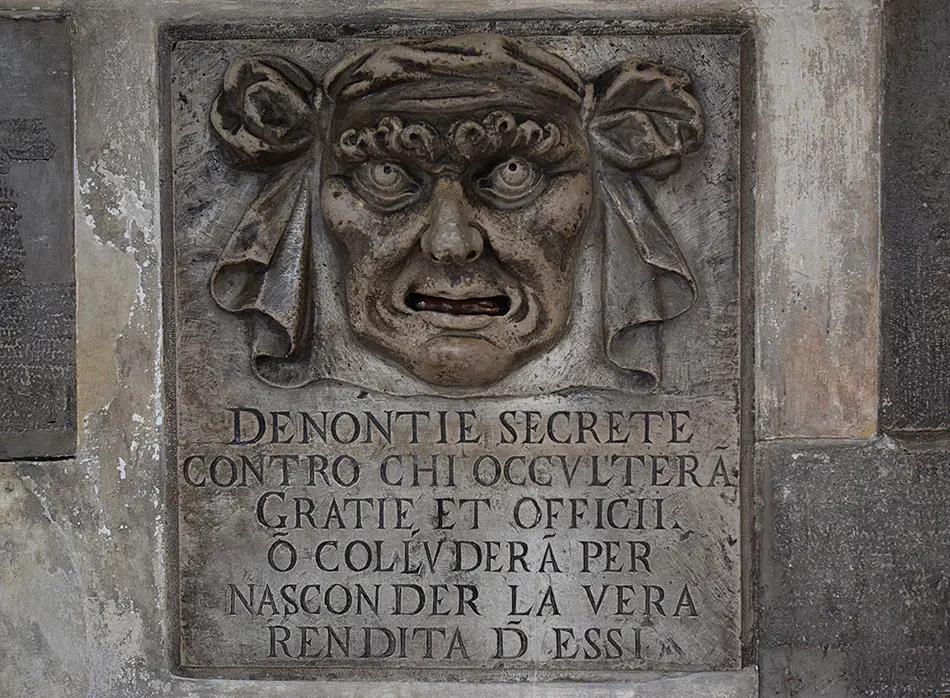
The Lodges
Climbed the Scala of Scarpagnino you enter the lodges, now home to different museum offices, where once there were offices of various magistrates and you can still see the boche de leon that received secret but not anonymous deletions (these were not considered) that alerted the Inquisitors and the Council of 10. Through the Scala d'Oro, flanked by a Hercules killing the hydra and an Atlas holding the vault of heaven by Tiziano Aspetti (1559-1606).
Doge's apartment - only open during temporary exhibitions
After the fire of 1483 these rooms assumed the current appearance; they were intended both for public life and for the private life of the doge. It consists of 20 rooms located above and below the central floor in use until the fall of the Serenissima. Here every doge, after the election, brought with him personal effects and furnishing objects that were removed by the heirs after his death. Today they host a path dedicated to the historical figure of the doge in the millennium of the Republic. The Sala degli Scarlatti gathered the ducal councilors. On the ceiling, by Pietro and Biagio di Faenza (the same in the Sala dell'Albergo of the Scuola Grande di San Marco), stands the doge emblem Andrea Gritti (1523-28), while above the door one can see the great predecessor sculpted Leonardo Loredan (1501-1521) and on the hood is the coat of arms of the Barbarigo (doges with Marco and Agostino from 1485 to 1501). Below the fireplace is a sixteenth century work by Tullio and Antonio Lombardo.
The Sala dello Scudo takes its name from the tradition of displaying the shield of the doge during the hearings; the visible one is by Ludovico Manin, the last doge in charge in 1797. On the walls the geographical maps illustrate the possessions of the Serenissima and the geographical discoveries attributable to Nicol� and Antonio Zen (they explored Greenland and perhaps arrived in North America in 1390) and Alvise Da Mosto (1432-1483), discoverer of some islands of Cape Verde in 1456. The two globes are from the sixteenth century and represent the Earth and the Sky.
The Sala Grimani takes its name from the patrician family who gave three Doges to the Serenissima, the coat of arms here is that of Doge Marino Grimani (1595-1605), also commissioner of the frieze that crowns the ceiling, which dates back to the Doges Barbarigo (1485-1501) whose coat of arms is found on the camimo, a work by the Lombardo. Also to a doge (Francesco, 1631-46) is entitled the Sala Erizzo that has the coat of arms over the hood and a frieze with military motifs. To the doge Pietro Grimani (1741-52) and to Marino Grimani (1595-1605) we owe the stucco decoration that gives the name to the room while the doge Antonio Priuli (1617-23) is the coat of arms on the fireplace. From the Sala degli Stucchi there was a walkway, demolished in the nineteenth century, which linked it to the Canonica di San Marco, now Palazzo del Patriarca, visible on the left of the Basilica of San Marco.
The Sala dei Filosofi is so called for 12 images present until the eighteenth century then replaced with images of doges. From this room the doge, through a staircase, reached the Senate meetings on the upper floor. Then there are some rooms identified with the ceremony of the audience, and the Sala degli Scudieri where used to stay the personal guard of the doge. From here a fifteenth-century monumental portal leads to the Scala D'Oro.
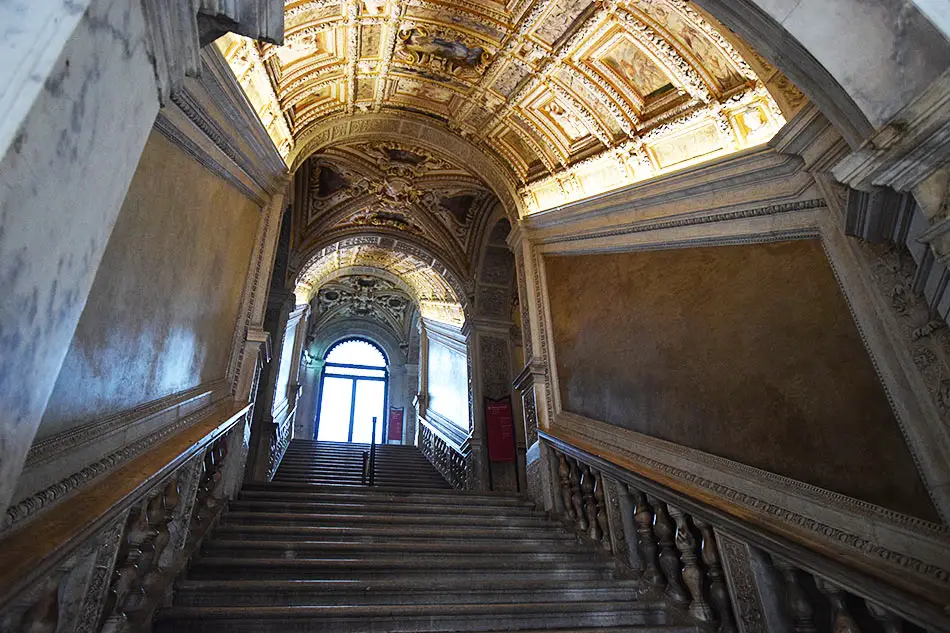
Golden Scale
The staircase continued the ancient direction of entry to the palace after the Scala dei Giganti. It is entered through a monumental portal, with the statues of Hercules killing the hydra on the left and Atlas holding the world on the right, both by Tiziano Aspetti (1559-1606), placed on sturdy columns with trabeation and broken arch from the coat of arms of the doge Andrea Gritti (1523-38). The Gritti actually saw only the previous wooden staircase while the Scala D'Oro was built starting from 1555 on a project by Jacopo Sansovino with the doges Lorenzo (1556-59) and Girolamo Priuli (1559-67), and terminated by Antonio Abbondi said the Scarpagnino (? -1549).
In 1557 Alessandro Vittoria then realized the decoration of the barrel vaults of the 24-carat white and gold stucco staircase. The first ramp is dedicated to the Cipride, or Venus, and therefore reminded those who entered the Venetian conquest of Cyprus. Another scene is dedicated to Neptune, always depicted in Venice to remember the hegemony of the city on the seas.
The Scala D'Oro was returned to its former glory in 2008 thanks to a 200 thousand euro loan offered by Bulgari.
Institutional Halls of Palazzo Ducale
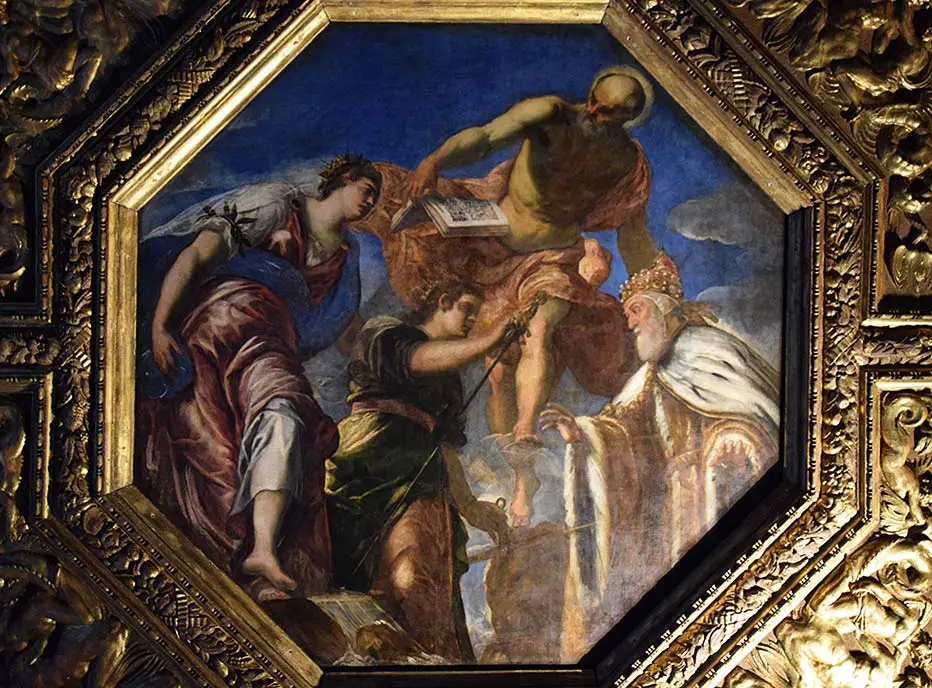
Square Atrium
Climbing the Scala D'Oro, the route then enters, from the second floor and through the Square Atrium, into the rooms dedicated to the management of politics. The atrium served as a waiting room for members of the government. The decorative apparatus, be it pictorial or sculptural, is inspired here by the virtues that must accompany good governance.
The ceiling, decorated completely by Jacopo Robusti called Il Tintoretto (1519-1594), presents in the center The doge Girolamo Priuli receives from the justice the scales and the sword (1565-67), at the corners the allegories of the seasons dating back to 1567.
On the walls, entering from the left in a clockwise direction are St. John the Evangelist writing the Apocalypse, Christ praying in the garden, Adam and Eve in the Earthly Paradise all realized between 1580 and 1590 by Paolo Caliari called Il Veronese (1528- 88), The Angel announces to the shepherds the birth of Christ by Gerolamo da Ponte known as Bassano (1566-1621).
From the Atrium Square a door leads to the Hall of the Four Doors.
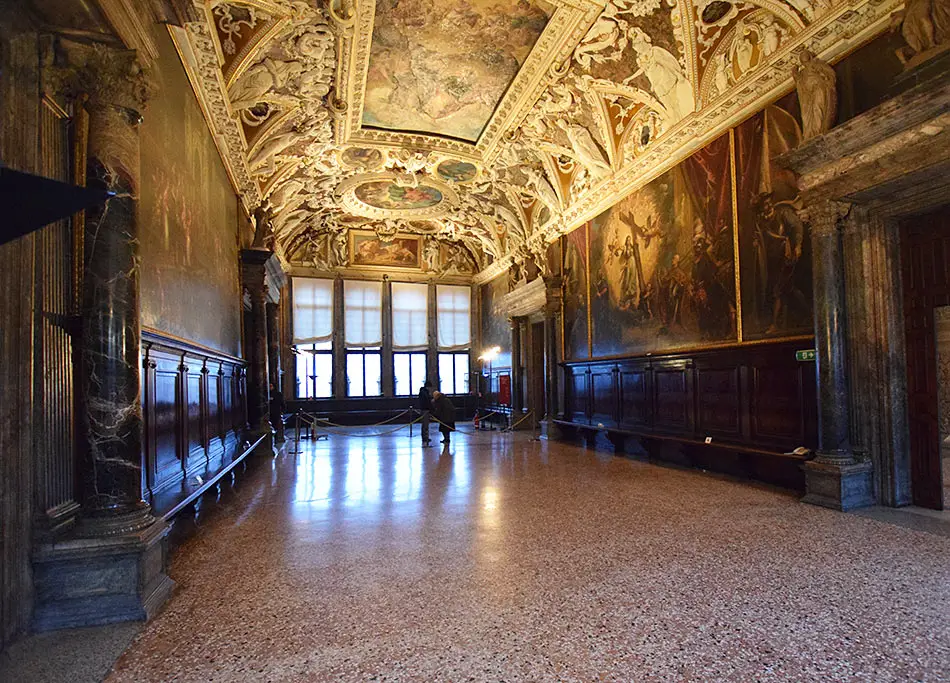
Hall of the 4 Doors
Always a waiting room was the beautiful Hall of 4 Doors rearranged, after the fire of 1574, calling for architecture Andrea Palladio and Gianantonio Rusconi (1500-1578) first and Antonio Da Ponte then (1512-1597) - the designer of the Rialto Bridge - and for the painting Jacopo Robusti known as Il Tintoretto (1518-1594) and Nicol� Bambini (1651-1739); their paintings are framed by stuccoes by Giovanni Battista Cambi, known as Il Bombarda.
The pictorial cycle of the ceiling is inspired by the founding of Venice, its independence and its dominion over the sea, the historical mission of the city and its patricians over the centuries.
The pictorial decoration of the walls includes historical episodes located at the center - The Arrival in Venice of King Henry III (1593) by Andre Michieli called Il Vicentino (1542-1617) and The Doge Antonio Grimani in adoration of the Faith and San Marco in glory (1555-76) by Tiziano Vecellio.
On an easel Venice that receives from Nettuno the gifts of the sea (1740) by Giambattista Tiepolo.
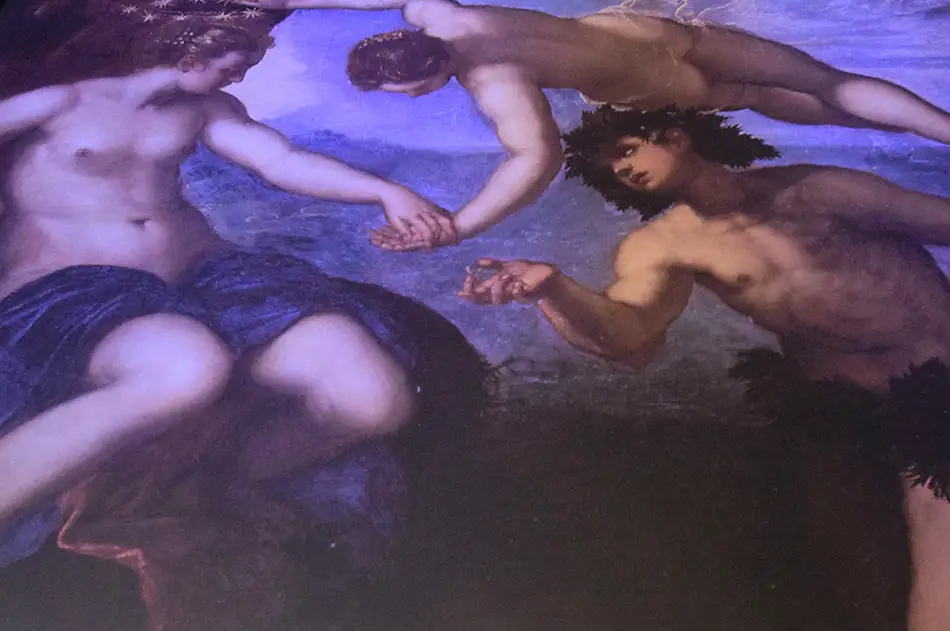
Hall of the Anticollegio
Another antechamber, but destined to await the ambassadors is the Sala dell'Anticollegio, also restored after 1574 on a project by Andrea Palladio (1508-1580) and Gianantonio Rusconi (1500-1578) before and terminated by Antonio Da Ponte then (1512-1597), the designer of the Rialto Bridge.
Giovanni Battista Cambi said The Bombarda here signs the ceiling barrel vault, with white stuccos and in pure gold, where in the center stands an octagonal fresco by Paolo Caliari called Il Veronese entitled Venice distributes honorficences (1577). On the right in oval The Abundance, on the left in oval The Justice, above The Meditation and under The Navigation, frescoes all signed by Marco D'Angelo Del Moro (1537-1586).
All around there is a beautiful frieze above the walls - once with leather panels - where in 1716 were placed the paintings of Tintoretto once in the Squared Atrium; it is the Wedding of Bacchus and Ariadne in the presence of Venus, La fucina di Vulcano, The Peace, Concordia and Minerva that drives away Mars, Mercury and the Graces all painted in 1576. It is an allegorical cycle on the wisdom of the government of Serenissima.
Here the works of Tintoretto are accompanied on the walls by a work (1578) by Veronese Ratto di Europa and Ritorno di Giacobbe by Jacopo Bassano (1515-1592).
The fireplace is the work of Vincenzo Scamozzi (1548-1616) and shows two telamons, attributed to Girolamo Campagna (1549-1625), while above it is carved the bas-relief Venus who asks for arms to Vulcan in 1586 by Tiziano Aspetti (1559-1606).
Through a monumental door, with Corinthian columns and sculptural group of Alessandro Vittoria on the upper side depicting Venice between the Concordia and the Gloria, one enters the Sala del Collegio.
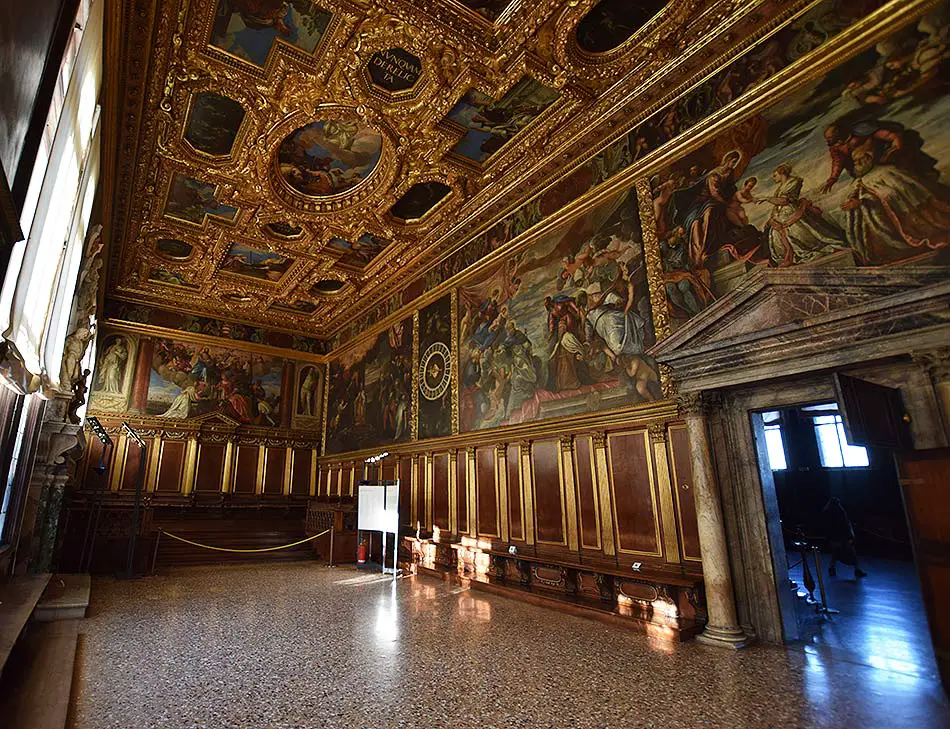
Hall of the College
A monumental door with a sculpture by Alessandro Vittoria leads to the Sala del Collegio, where the Savi and the Lordship met. The Savi (founded in 1380), in principle one for each sestiere, grew in number including 5 Savi for the Mainland and 5 Savi to the Orders (responsible for the fleet and the sea domains); they were the ministers of the Republic. The Lordship (composed of the doge and the Minor Council or the 6 helpers of the doge, one for each sestiere, and the 3 leaders of the Quarantia (founded in 1179), responsible for the management of justice, taxation and appointments of the new members of the Senate and of the Maggior Consiglio). When the College was presided over the Lordship it assumed the name of Full College. The College regulated and coordinated the work of the Senate, which met in the adjoining room, receiving embassies and acknowledging the ducal letters and the decrees of the State.
A hall so important had to have a decoration that communicated to foreign visitors the ideals of the Republic; on an architectural project by Palladio (1508-1580) and by Giovanni Antonio Rusconi (1500-1578), in a carved wooden ceiling by Francesco Bello and Andrea da Faenza (a workshop by Palladio) a pictorial cycle by Paolo Veronese is inserted here made in oil on canvas.
In this pictorial program the government of the city relies on the Faith surrounded by the Virtues, the Faith force of the Republic is at the center, next to the tribune Venice enthroned with Justice and Peace (1575-78), towards the Hall of Anticollegio Marte and Nettuno (1575-78) behind which stands the bell tower of San Marco.
There are then 8 L-shaped and angular L-shaped side paintings representing the Good Government Virtues identified by the accompanying symbology; in the corner towards the tribune: under L you can see The Fidelity (dog), above The Prosperity (cornucopia); sideways to T under The Meekness (lamb), above The Vigilanza (crane); alongside The Semplicity and The Purity (ermine) below, above The Dialectic e The Industry (spiderweb), finally L under The Reward (nut and crown), above The Moderation (acquila). All painted by Paolo Veronese in the three years 1575-78.
The smaller paintings of the ceiling in a clockwise direction starting from the tribune side: in octagon the motto Custodes Libertatis of anonymous, in oval The Sacrifice of Caronda (Paolo Veronese), in elongated octagon The Sarificio di Decio (Paolo Veronese), in oval La Forza d'Animo by Scilla (Paolo Veronese), in the octagon side door of the Anticollegio the motto Robur imperii (anonymous), in oval La Fortezza di Alessandro (Paolo Veronese), in an elongated octagon Alessandro's Offer over twelve altars (Paolo Veronese), in the oval Blinding of Seleuco (Paolo Veronese).
On the wall, above the doge's bench, a Battle of Lepanto reminded everyone of the great success of Venice against the Turks (1571) with admiral doge Sebastiano Venier, who is found in the Veronese painting Votive portrait of the doge Sebastiano Venier.
In the room there are two other paintings by Tintoretto: Andrea Gritti, assisted by S. Marco, before Maria and Ss Bernardino, Luigi and Marina and Mystic Wedding of Santa Caterina to whom assists the Doge Francesco Don� surrounded by Prudence, Temperance, Eloquence and Charity.
The large and wonderful fireplace, also here as in the previous room, is the work of Girolamo Campagna (1549-1625); here the telamons depict Hercules and Mercury.
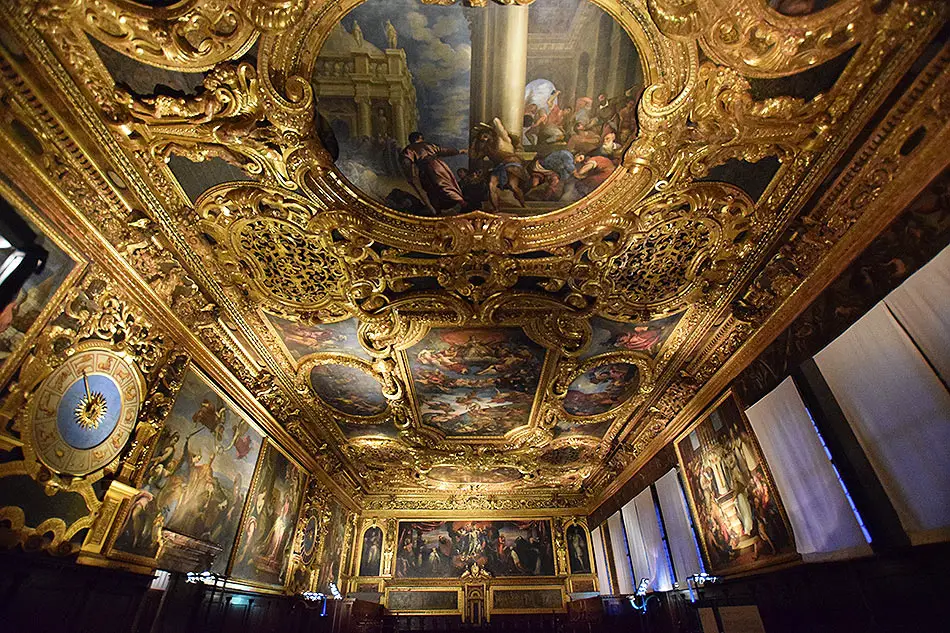
Hall of the Council of the Pregadi or Senate
Between the Halls of the Collegio and the Hall of the 4 Doors is the Sala dei Consiglio dei Pregadi, today the Senate, so called because its members were invited or "requested" in writing to meet to give their opinion. The Senate, created in 1229, was composed of the Pregadi, 60 members elected annually by the Maggior Consiglio among the patricians who had distinguished themselves by value, joined by Zonta (20 senators elected from 1279 if necessary, stable and annual from 1506 in number 60) and presided by the Doge; while his works were prepared by the Collegio dei Savi. All senators dressed in red. During the following centuries only the richest and most powerful patrician families had access to the group of senators.
The Hall is accessed via a marble door with a frieze and simple lintel. Here were the masterpieces of Carpaccio, Giorgione and Tiziano went up in smoke in 1574; the next pictorial installation saw Tintoretto, Jacopo Palma the Younger and Marco Vecellio, nephew of Titian, who worked under the Dogado of Pasquale Cicogna (1585-95).
Immediately above the entrance door you can admire Allegory of Victory on the League of Cambrai (1590), then clockwise on the walls are the following paintings:
Oil paintings on canvas on the walls of the Sala del Senato
- Allegory of victory over the League of Cambrai (1590-95) by Jacopo Palma il Giovane; in the long wall above the door that comes from the Sala del Collegio.
- The Doge Pasquale Cicogna in prayer before the Savior (1590-95) by Jacopo Palma il Giovane; in long wall.
- Doge Francesco Venier presents the cities submitted to Venice (1590-95) by Jacopo Palma il Giovane; in long wall.
- Obedience (1585-95) by Jacopo Palma il Giovane; in long wall.
- The Equity (1585-95) by Jacopo Palma il Giovane; in the tribune.
- The Dead Christ adored by the Doges Pietro Lando and Marcantonio Trevisan (1590) by Jacopo Robusti known as Il Tintoretto; in the tribune.
- The Intelligence (1585-95) by Jacopo Palma il Giovane; in the tribune.
-The Philosophy (1590-95) by Jacopo Palma il Giovane; in long wall.
- San Lorenzo Giustiniani blesses the crowd in the Church of Castello di Marco Vecellio (1545-1611)
- The Prudence (1590-95) by Jacopo Palma il Giovane; in short wall.
- Doges Girolamo and Lorenzo Priuli praying before the Redeemer (1590-95) by Jacopo Palma il Giovane; in a short wall above the door that leads to the Hall of the Four Doors.
- The Justice (1590-95) by Jacopo Palma il Giovane; in short wall.
- The Peace (1585) by Jacopo Robusti known as Il Tintoretto; in long wall.
- Doge Pietro Loredan pleading with the Virgin (1581-85) by Jacopo Robusti known as Il Tintoretto; in long wall.
Oil paintings on canvas on the ceiling of the Sala del Senato
- Venice, seated among the gods, receives the gifts of the sea (1584) by Jacopo Robusti known as Il Tintoretto; in the center of the ceiling.
- Officina dei Ciclopi with Venus superintendent by Andrea Michieli called Il Vicentino; oval side of the Sala del Collegio.
- The masters of the mint coin coins supervised by the supervisors by Marco Vecellio (1545 - 1611); biovale tribune side.
- The doge welcomes historians and poets by Antonio Vassilacchi (1556 - 1629) called L'Aliense; oval side long wall with windows.
- Doge Pasquale Cicogna worships the Eucharist on the occasion of the consecration of the Church of the Redeemer by Tommaso Dolabella; biovale short side Hall of the Four Doors.
- The Wisdom by Tintoretto; on the left side of the tribune.
- The Truth by Tintoretto; above the tribune on the right.
- The Military Value by Marco Vecellio; short side Hall of the Four Doors on the left.
- The Liberty by Marco Vecellio; short side Hall of the Four Doors on the right.
From this room the path proceeds returning to the Sala Delle Quatto Porte to head towards the Sala del Consiglio dei X.
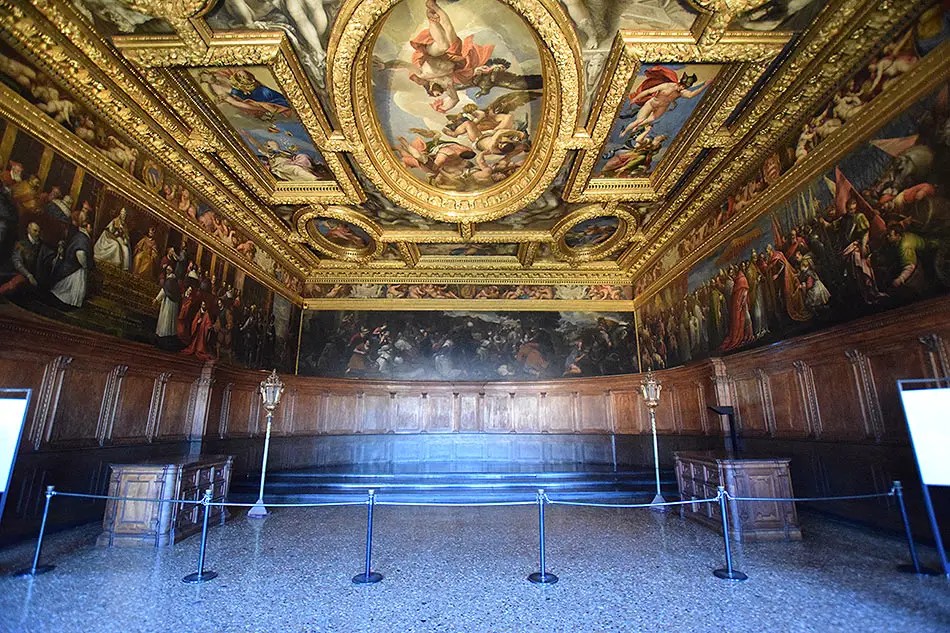
Hall of the Council of Ten
The Hall of the Council of Ten presents an earlier decoration of at least 20 years, where a young Paolo Veronese, a pupil of the Ponchino, created 3 of the 25 canvases that house the wooden ceiling frames. The cycle with deities and allegories recalls the purpose for which the Council was responsible, namely to punish the crime. At the center Jupiter that strikes the vices of Veronese, a copy of the painting stolen by Napoleon in 1807 that now stands at the Louvre.
The Council of Ten was born on 10 July 1310 in response to the conspiracy of Bajamonte Tiepolo, but the danger of the escape from the Maggior Consiglio (after the Serrata of 1297) for decades and possible returns to the conspiracy became stable (20 July 1335) and elected annually by the Major Council, in number of 10 patricians chosen by the Council of the Pregadi or Senate, to which was added the doge and his Minor Council of 6 patricians; 17 patricians in all - like the semicircles of the hall - that I discussed on investigations and on-going trials against the enemies of the state. It was the Council that decided the execution of the Doge Marin Falier (1355), guilty of wanting to create a hereditary monarchy.
The other paintings: Old Oriental and young woman (in oval) and Giunone offers the ducal horn, gems and gold in Venice by Paolo Veronese (1554-56); Venice on the globe and on the lion (in oval) and Venice or Venus between Mars and Neptune by Giambattista Zelotti; Mercury and Minerva by Giambattista Ponchino.
For those who make the Route of the Secret Itineraries through a wardrobe you enter the Sala dei Tre Capi; to these, elected monthly by the Council of Ten, the task was to open the letters and convene the Council to instruct the process. Here there are works by Tintoretto, Veronese, Giambattista Ponchino and Giambattista Zelotti including Victory of Virtue on Vice.
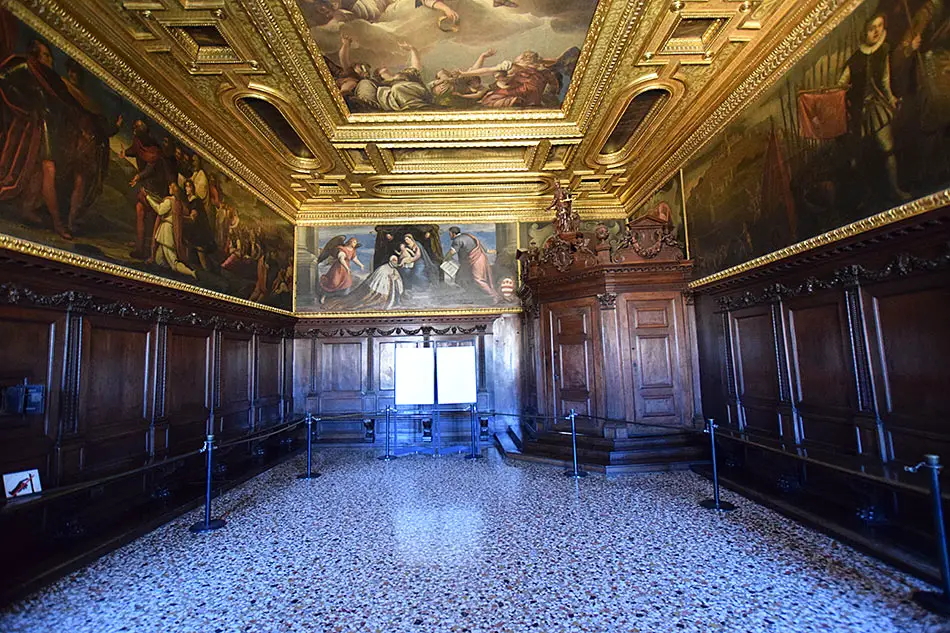
Hall of the Bussola
The candidate to submit to the trial by the Council of Ten entered the next Hall of the Bussola, said so for the presence of a wooden compass surmounted by the statue of justice, and from here in the Hall of Three Heads, in that of the Council of X and in the Hall of the Inquisitors (these were magistrates, elected between the Council of Ten and the Councilors of the Doge, who guaranteed the security of the Secret.They were established in 1539 following a flight of state secrets by a French ambassador. since they could apply torture methods, here are paintings by Tintoretto).
In this room, with wooden rails on the walls you can see a fireplace designed by Sansovino (1554) while on the ceiling there was a painting by San Marco and the theological virtues of Paolo Veronese stolen, now in the Louvre.
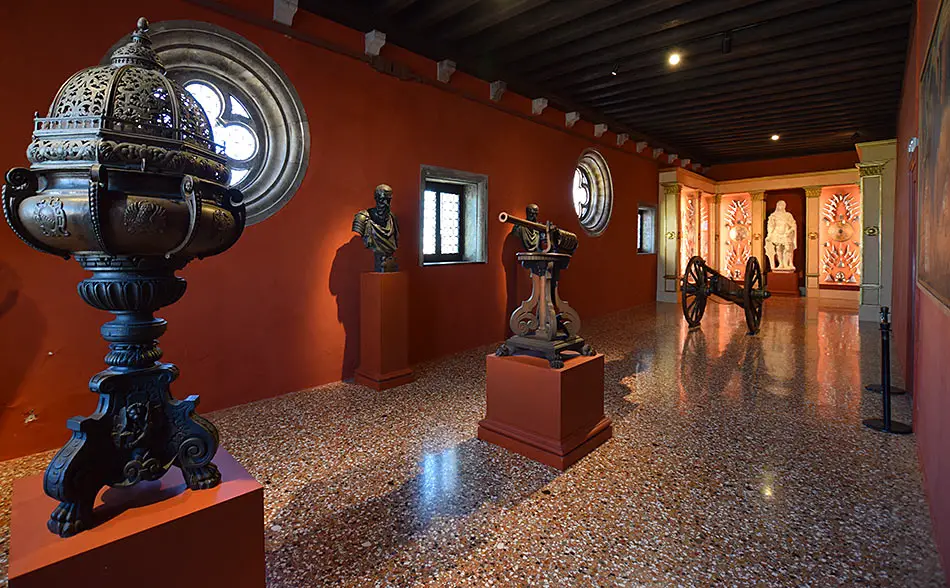
Armory
From the Hall of the Bussola we pass to the Armory, composed of four rooms where from the fifteenth century weapons and ammunition were kept ready to be used by the palace guards, on whom, on certain occasions, arsenalotti, specialized workers of the Arsenal were added. At the end of the Republic the Armory was sacked by Napoleon and many pieces were lost. Today there are around 2,000.
Room I also takes the name of the condottiere Erasmo da Narni, known as Gattamelata, a leader soldier who defended Venice, for the armor shown here along with other sixteenth-century swords, crossbows and lanterns of Turkish ships.
Room II presents a banner taken from the Turks at Lepanto in 1571 and an armor belonging to the French king Henry IV and an armor for equine head, swords and halberds. The latter can be found in Room III together with an arquebus with 20 firearms (16th century) and a decorated cannon (16th century). The hall is named after the Doge Francesco Morosini (1688-1694), a great fighter in Heraklion and in many Mediterranean islands but also responsible for the collapse of the Parthenon roof in 1687. The Senate gave him the title of the Peloponnesian and the honor of this bust - once in the Sala del Consiglio dei X - with the dedication "The Senate to Francesco Morosini, the Peloponnese, still alive".
Still weapons, accompanied here by instruments of torture, are exhibited in Room IV along with the devil's box containing 4 gun barrels that shoot at the opening of the box.

Bridge of Sighs
The itinerary includes a passage through the Bridge of Sighs, built in 1614 by a project by the architect Antonio Contin (1566-1600) nephew of Antonio da Ponte, the designer of the Rialto Bridge. The bridge is divided into two corridors that connect it with the Sala della Quarantia and with the Sale dell'Avogaria and the Parlatorio. There is also an internal staircase connecting below the Wells o Pozzi, the first prisons, and above the Piombi, the second prisons of the city.
Go to the page of Bridge of Sighs
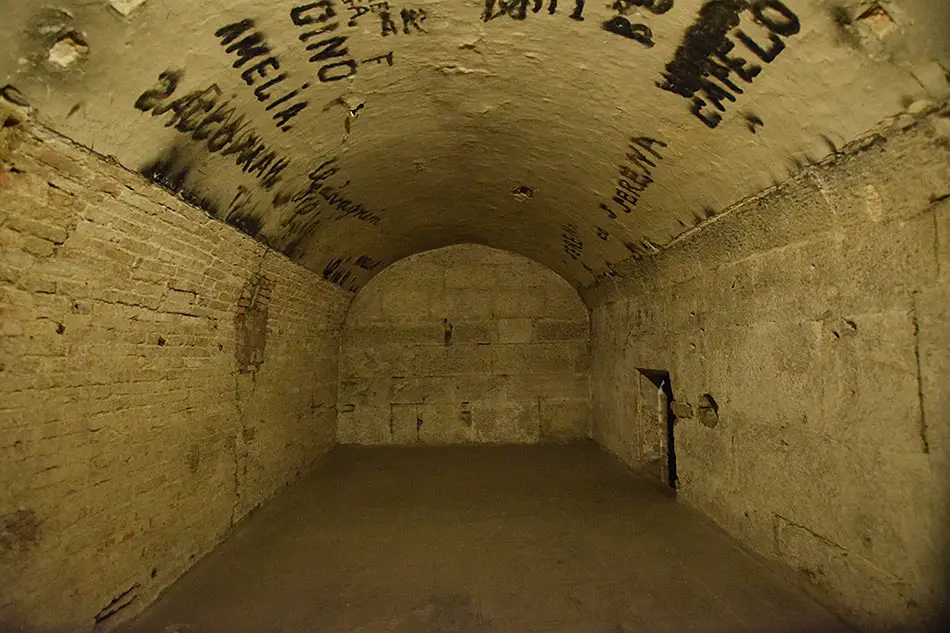
New Prisons or Prigioni Nuove
After the bridge there are the Prigioni Nuove, wanted by the Serenissima to give prisoners better conditions of detention, on a project started by Antonio da Ponte n. 1589 and completed by Antonio Contin in 1615. This is the first example of an isolated building used as a prison State. The cells, though more airy and luminous, nevertheless proved to be very harsh for the prisoners who were imprisoned here; among them Giacomo Casanova who managed to evade by telling it in a book called Storia della mia fuga dalla Piombi.
From the Armeria you go down to the first floor and you enter Liag� (in Venice a suspended terrace exposed to the sun) where there are three 15th century sculptures that decorated the Arco Foscari of the courtyard: the Portascudo, Adam and Eve. This was the space where the patricians relaxed in the pauses of the Maggior Consiglio's long sessions, moments that certainly served to define also different political strategies.

Sala della Quarantia
From here we pass to the Sala della Quarantia where paintings from the seventeenth century are exhibited on the walls. Here was the Quarantia, an institution founded in 1179 formed by 40 people (chosen by 9 electors nominated by the Concio, an ancient popular assembly) who elected the Doge and remained active with him, the Senate and the Major Council in the administration of the power. After the 1297 lockout, the Quarantia took care only of the screening and approval of the new appointments of the Major Council and of the Council of Pregadi, of fiscal matters and of the State Mint; finally after 1380 he assumed the office of supreme court and in the fifteenth century divided into three branches dividing into Quarantia criminal (the old Quarantia, with dedication to the criminal branch), Quarantia Civil (1441 then became Quarantia Civil Old in 1491, for the civil branch ), Quarantia Civil Nuova for the mainland in 1491.
History
The first foundations of Palazzo Ducale date back to the ninth century when the doge Angelo Partecipazio moved the seat of the government from the island of Malamocco to the Rivoalto or Rialto area (810) and built a defensive area at this point, the Palatium Duci. At the beginning it was nothing but a garrison of power with purely defensive purposes of the person in charge at that time. The building consisted of various modules that were accessed by a fortified door that was near the point of the existing Porta della Carta; some remains of fortifications and corner towers have survived today. In 976, during a revolt against the doge Pietro IV Candiano, the fort was burned down but was immediately rebuilt by his successor the doge and saint Pietro I Orseolo.
Still damaged by fire, the palace was rebuilt with the doge Sebastiano Ziani (1172-1178) but this time with a less military and more administrative structure. Ziani, in fact, became a bearer of the new political season of the Serenissima, which proposed a management of oligarchic power by the patrician families and no longer the absolutist of the monarchical type. Even this construction remains very little to the exclusion of some terracotta herringbone flooring.
The current structure began to take shape with the interventions carried out in the XIV century under the doge Bartolomeo Gradenigo (1339-1343). For the occasion the Paduan painter Guariento was called to decorate the eastern wall of the Great Hall of the Maggior Consiglio and Delle Masegne to make the windows. The facade on the pier was finished in 1404 while in 1423 the projects of the sides in front of the Marciana and the side of the Basilica began; later the Porta della Carta (1438-1442) was also realized
The Maggior Consiglio, the highest political organ of the Republic of Venice, met here for the first time in 1419.
With the doge Francesco Foscari (1423 - 1457), the part of the Palazzo Ducale was also renovated towards the square that was to be used for the administration of justice. From this period is the combo of the so-called Androne Foscari (1478-1485).
In 1483 it was the turn of a great fire that affected the side of Palazzo Ducale overlooking the canal that at the time housed the Appartamento del Doge. Antonio Rizzo took first of the reastaur and then the maestro Pietro Lombardo. The latter is the signature of all the sculptural decoration of the facade and the Scala dei Giganti. He was succeeded by Antonio Abbondi, called "Lo Scarpagnino", who completed the sculptural decorations in 1559. At this point Palazzo Ducale can be said to have been completed in the manner in which we know it today.
However, the fires did not stop: in 1574 and in 1577 the fire brought destruction in the Sala dello Scrutinio and in the Sala del Maggior Consiglio taking away smpre masterpieces of Gentile da Fabriano, Pisanello, Alvise Vivarini, Bellini, Titian, Carpaccio; for the reconstruction it was also called the Palladio in the city but little is known of its influence in the project.
With the displacement of the ancient prisons to the present site by Antonio Contin (1600), which connected them to the Doge's Palace via the Bridge of Sighs, some important spaces were freed adjacent to the courtyard and for this reason it was decided a significant reorganization: it was built a Renaissance portico and alongside the Foscari arch a marble fa�ade was built with arches and a clock designed by Bartolomeo Manopola (1615).
Passed undamaged and placidly through the eighteenth century Palazzo Ducale saw its end as the seat of power on May 12, 1797 when the Great Council sanctioned the end of the Serenissima under Napoleonic and French menace. In the nineteenth century the entire building was used as administrative offices first French and then Hapsburg and was also home to the Marciana National Library.
With the annexation of Venice to Italy (1866) Palazzo Ducale became the property of the Italian State but had to wait for a new restructuring and 1923 to know a new history, the modern one, of the greatest museum of the city and of Italy with more than 1 million and 400 thousand visitors who enter each year for the Porta del Frumento which faces Bacino San Marco.
How to reach the Doge's Palace Museum
The Doge's Palace Museum is located in San Marco in Piazza San Marco. From Rialto it can be reached in 5 minutes on foot.
From Rialto, from the Railway Station and from Piazzale Roma, take line 1 with Vallaresso or San Zaccaria stop. Or the line 2 (fastest) with San Zaccaria stop.
Watch the Video by Venice Civic Museums of Doge's Palace Museum
|


